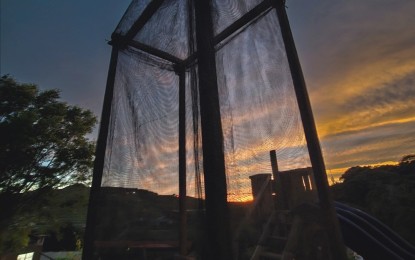nCa Report
While the Khalifa University and MIT are doing great work in developing the technologies and methods for pulling water from the air, a startup in the Philippines has come up with another approach.
For details on this, we turn to an article by Ms. Liza Agoot, which she wrote for PNA (the Philippines News Agency). It was published by PNA on 12 April 2024, and subsequently carried by several publications.
The title of the article is: ‘Startup Benguet firm catches mist to help solve water shortage’
We quote extensively from her article:
BAGUIO CITY – Amid the frequent shortage of water aggravated by the El Niño phenomenon, a technology is being tried in Atok, Benguet, to help address the situation and avoid wastage.
The fog catcher and water harvesting project of startup firm FarmConnect is deemed one of the solutions to ensure stable water supply, especially in highland areas.
It helps collect about 20 to 25 liters of water produced by mist from the morning fog.
“It will only take about five hours to install. It is not expensive and with the help of our architect and engineer we were able to give a sturdy attribute to the fog catcher that can withstand heavy wind, hurricanes and other effects of climate change,” Miguel Mercado, project lead and program management trainer, said in an interview.
Link to the article of Liza Agoot at PNA
https://www.pna.gov.ph/articles/1222490
The fog catcher is made of a steel scaffolding-like brace with a height of 6.25 meters (about 20 feet) and erected on 38 square meters of land.
It is wrapped with a nylon mesh that will allow the mist to be caught, dripping to the bottom where the collection is made.
The catcher is located in Haights Farm, a pioneer in modern highland farming techniques and where the famous Sakura Park is.
Atok registers zero to 24 degrees Celsius, depending on the time of the year.
Benguet, Ifugao and Mountain Province produce 85 percent of temperate vegetables, like potatoes, carrots and cabbages.
“The initial implementation is at Haights Farm but we intend to expand to neighboring areas and even the lowland Atok, but we will use a different technology,” Mercado said.
“Water scarcity and rationed water supply are the top reasons why we can’t sustain proper irrigation for our crops, combat harvest wastage from night frosts, and even simply support local tourism,” he said.
The project will also involve non-agricultural industries in fostering sustainable farming communities and supporting grassroots solutions to current social and environmental issues.
Aida Pagtan, Department of Agriculture-Cordillera chief of the Regional Agriculture and Fisheries Information Service, said in an interview Friday that a similar innovation was introduced by Saint Louis University in Mount Santo Tomas in Tuba, but failed.
“It did not work because the fog is just passing the area, preventing the capture of water. We hope that the one in Atok will work because it is beneficial for the farms and the people,” she said.
Atok Mayor Franklyn Smith, in a phone interview, said innovations are beneficial but assessments have to be done to see the output.
“We can introduce it to the farmers if it is functional,” he said.
The mayor said they have funded similar projects in the villages of Paoay and Cattubong, the highest villages in the province, but they remain under study.
* * *
Central Asia is doing considerable work in water saving technologies while simultaneously highlighting the need for the economization of water.
It would be useful to collect the knowledge about all the new and emerging technologies and methods for pulling water from the air. The consolidation of the knowledge would definitely be an ongoing work because new developments are taking place almost every day.
Together with this, there would be need to see as to what works best in the climate and conditions of Central Asia. For this, there should be the two-pronged approach: At one level, it should be the close cooperation between the research institutions of Central Asia with the research institutions in other countries that are engaged in this kind of work. For the implementation of the successful solutions, there would be the need for the public-private partnership. /// nCa, 11 July 2024 [CONCLUDED]
